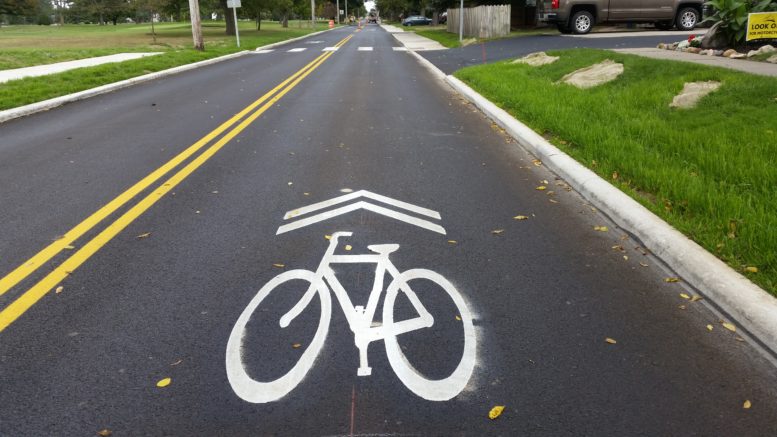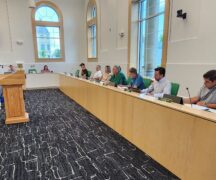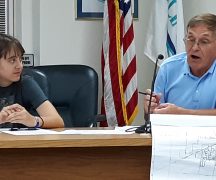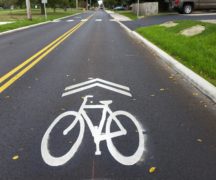By JAN LARSON McLAUGHLIN
BG Independent News
Bowling Green City Council’s Transportation and Safety Committee did some backpedaling Tuesday evening after voting to reject some bike sharrows in order to save some street parking.
The committee was presented with the city’s Bicycle Safety Commission’s recommendation that bike sharrows be considered for the newly reconstructed Maple and Clay streets. Bike sharrows are now discussed when streets are repaved, so the bike decals can possibly be added to the projects. The sharrows don’t designate bike lanes, but alert motorists to frequently used streets for bicyclists.
While Clay Street was a low priority for the bike commission, Maple Street ranked high for bike accommodations since the street links Bowling Green City Park with the Slippery Elm Trail.
However, putting bike sharrows on either Maple or Clay streets would mean parking would have to be removed on those streets, according to Joe Fawcett, assistant municipal administrator.
To be safe for bicyclists, the sharrows would have to be 11 feet from the curb so bikes could clear the “door zone” of parked cars. Neither street is wide enough for both, explained Brian Craft, public works director.
All of the properties along Clay and Maple have their own off-street parking. But often residents aren’t keen on losing street parking near their homes.
Steve Langendorfer, head of the city’s Bicycle Safety Commission, recalled the last time the city considered removing street parking in order to put bike sharrows on the section of Conneaut Avenue between North Grove Street and Fairview Avenue.
“I remember all too well the heated discussions about that block on Conneaut,” Langendorfer said. “People were extremely upset about losing their parking.”
The houses in that block had off-street parking, but residents protested anyway.
“People just don’t like to lose what they already have,” he said.
Maple Street has been on the top of the bike commission’s list for a long time for bicycle accommodations. “Maple Street is one we really, really want to have,” Langendorfer said. But he added, “I don’t want that kind of animosity between residents and cyclists in town.”
The Transportation and Safety Committee – made up of council members Bill Herald, Mark Hollenbaugh and Neocles Leontis – discussed other options.
Leontis asked about just putting the sharrows on one side of the streets, or in the middle with the bike decals headed in both directions. But it was agreed that those options could pose confusing messages for bicyclists and motorists.
Herald noted that those streets will still have the signs posted saying “Bikes may use full lane.” But eliminating street parking was not an option he would support.
Taking away parking “is a no-starter for me,” he said.
So Herald made a motion that Clay and Maple streets would not get sharrows on the pavement, but would retain street parking and the signs on the side of the roadway.
Voting to preserve the street parking were Herald and Hollenbaugh. Voting against was Leontis.
Then Mayor Mike Aspacher came to the podium to speak. He recalled the protests from Conneaut Avenue residents opposed to the loss of their street parking. “It was loud,” he said.
But the mayor said the expectations of city residents are changing, with many more supporting the concept of “Complete Streets” providing accommodations for motorists, bicyclists and pedestrians.
“I hear it more and more all the time, from young people and old people,” he said.
Aspacher asked the Transportation and Safety Committee, “What are the purposes of streets?” Are they to provide parking, or to create a more mobile community, he asked.
“I understand the political difficulty of getting rid of street parking,” he said. “But the pressure for ‘complete streets’ is only going to grow.”
Aspacher encouraged the committee to look toward the future.
“It’s going to take some political will,” he said. “We all have to make some tough decisions. This is a moment in time that presents an opportunity.”
Herald responded that the choice between street parking and sharrow decals on the street was clear to him.
“In my estimation, it’s not worth it,” he said, adding that some residents don’t have adequate off-street parking. “It’s not worth it to disrupt an entire neighborhood.”
Then Neocles suggested that perhaps the city should be looking at more ambitious plans – like bike lanes – which may make eliminating some street parking worthwhile. Neocles asked the city administration to bring information on bike lanes to the committee.
Hollenbaugh agreed that the committee should not be making a decision without having all the pertinent information. He also asked to see the Bicycle Safety Commission’s report on bike lanes.
So Hollenbaugh made a motion to undo the previous motion to reject the bike sharrows to rescue street parking. Leontis said the action on these two streets could set the tone for future bike accommodations on city streets.
All three council members voted to rescind the first motion.





